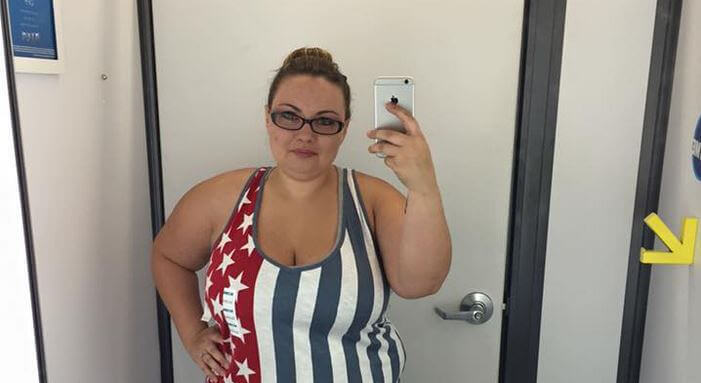
Source: Brandy Melville
I have been confused about some reactions to this brand’s “essence”, yes they use skinny blonde girls as models and they don’t make large sizes, what’s new? Most models are skinny and that is not going to change: even where there is an increasing diversity in the body types you see in the media, including celebrities and all sorts of performers, fashion remains a skinny affair. While the limits of what is “too skinny” are subjective and, some would argue that the Instagram famous Italian brand has regular sized models, there are definitely strong feelings on both sides of this argument and the brand seems to have as many lovers as haters.
when is brandy Melville going to realize 1 size doesn’t fit “most” ??
— jordan :)) (@jj_wills) August 16, 2015
if i could own every piece of clothing from Brandy Melville i would be one happy person ngl — Jos (@JosieGrimaldi) August 13, 2015
Is in ethical for a clothing brand to make only small sizes? What if they made only big sizes? Would that be unfair to thin people? We want to explore why it is not a corporation’s job to make girls feel better about themselves.
What are normal sizes?
Brandy Melville markets to teenagers, so there is a natural size filter, and the tradition of some known fashion houses to only make certain sizes is well-known. Vanity sizing and extra large clothing sold in America has somehow changed the standard and now consumers expect bigger clothes, since a “small” garment can be actually a large in some stores. Also to be noted is the fact that the brand started in Italy, where women are generally thinner that in America: the United States tops global obesity rates, what is “normal” here is not in the rest of the wold.

Obesity among adults, 2012 or nearest year. Source: OECD Obesity update 2014
Even when the clothes are meant to be worn by teenagers, the Italian label is under constant attack for offering one-size options that some people think are “too small”.
Being a teenager is tough
Articles on The Huffington Post, Slate, Refinery29 and Racked point to the effects this company’s sizing policy can have on teenagers’ perception of themselves, creating a standard that is unrealistic or unattainable for some girls, which could lead to eating disorders and other behavioral issues. On the other side, are those who feel that they can actually find sizes that work for them, since clothes sold in America are bigger than what some skinny teens want to wear.
In an ideal world where body size, character, and worth were not conflated, perhaps a store like Brandy Melville could coexist with the department stores and plus size stores. But we do not live in that world, and girls above a certain size are already taught they’re not good enough. – Slate
Blaming a company’s clothing for teenagers’ self-esteem issues is missing the point. The fashion industry, in general, from high-end to fast fashion uses imagery that consumers want to identify with: happy people, attractive women and a comfortable lifestyle. Is it the fashion, TV or movie industry to blame for girls feeling fat? To some degree, of course, but what can have a bigger impact are family values and character building. Raising confident girls that don’t feel the need to use a lot of makeup or buy new clothes every week to feel good or accepted is a hard job when they are being bombarded with airbrushed photos, Instagram feeds and videos featuring “perfect” bodies and faces, but blaming private enterprise is not the solution to a crisis of values.
Why can’t those girls just say: “this doesn’t fit me” and move on? Why is it so important to wear what “everybody” is wearing? If you were even a teenager, you can understand why this is an issue and why today this might seem silly but not at all for a younger version of yourself. Seeking for acceptance is one of the biggest struggles growing up, but those struggles are there, with or without BM.
The body shaming game
There is a trend in the media and some feminist circles to somehow champions obesity and condemn skinniness as a female-oppressing world syndrome. A story posted on the 4th of July about a girl “standing up for herself” at Old Navy (a.k.a. the devil) by taking a selfie with an XL tank top after overhearing an apparently hurtful comment. The story goes like this:

Woman takes a selfie at Old Navy after hearing apparently hurtful comments about extra large sizes. Source: CNN, photo by Rachel Taylor.
Random kid grabs an extra large tank top (which wasn’t a great piece of fashion, by the way) and tells her mom: ‘ Look! Me and So-and-so can fit in this tank top!’ Her mom laughed and said, ‘Yeah, you could! That thing is huge!’ After which the woman in question said to go to her car and cry. Later, in an act of courage, she went back to the store, bought the top and posted a selfie she took in the dressing room on Gap’s Facebook page. The story got some coverage and went mini viral (helped by the fact that the top in question featured the American flag). The story was covered with a “you go, girl” tone to it, but nobody asked: why did a simple comment made her cry? Is being overweight what bothers her or just hearing it from someone else? Crying about an aspect of your life means there is something wrong with it or that you are unhappy about it. If you are sad because you are fat and it’s evident to the world, the solution is not to go and buy clothes. I’m glad she got over the apparently “hurtful” comment, but there is a big difference between accepting yourself and being unhealthy and content with it. One of the headlines called the event “inspiring” and the expression “body-shaming” was frequently used in the articles mentioning the incident, even when there was no direct “shaming” or implications other that “this top is very big”.
Fat is Wack
In spite of many people saying that being fat doesn’t mean someone is unhealthy, the evidence proves the contrary. According to the OECD:severely
– obese people die 8 to 10 years sooner than those of normal weight, similar to smokers
– every 15 extra kilograms increase risk of early death by approximately 30%
– obesity is estimated to be responsible for 1% to 3% of total health expenditure in most countries and 5% to 10% in the United States
Using an adjective, fat, is not body shaming, specially when it wasn’t directed specifically to you and there weren’t any negative qualities attached to it. Saying somebody is fat is NOT body shaming, specially when they are, in fact, obese. The OECD defines obesity as follows:
Obesity is defined as a body mass index (BMI) of 30 kg/m2 or more. The BMI is a single number that evaluates an individual’s weight status in relation to height (weight/height2), with weight in kilograms and height in metres)
Thus, there are measurable ways to categorize someone as fat or obese and there could be different measurement methods, but the takeaway is that “fat” is just a word to refer to your body mass index. Social perception of obesity is a different concept, according to research at the University of Alberta shows that when a thin person is seen lying down watching television, people assume they’re resting, but when people see an overweight person relaxing, it’s automatically assumed they’re lazy and unmotivated. Whether those social perceptions are fair or realistic is not for me to assess, but the fact that the word “fat” has negative connotations does not erase the fact that it is just a word and not an insult, as some media outlets imply. If obesity is such a negative condition, why does the media seem to sympathize more and more with the idea that being overweight is good?
Who wears Brandy Melville?
Anyone who can. Brandy Melville’s style is relaxed, casual, generic enough and girly but yet timeless and versatile. They do follow some big picture trends, but for the most part, clothes have basic lines and colors that can be worn from school to the beach to the mall to a party (a BM girl’s go-to spots). The California girl theme seems to be present in most promotional photos and lookbooks, and girls everywhere seem to love the brand. Recently, fashion blogger Rumi Neely wore a one-size BM dress and she’s been seen wearing multiple BM clothes on her blog, she is 32.
???????? A photo posted by Rumi Neely (@rumineely) on
I have to be honest, if most of their clothes were not made of cheap polyester, I would own more Brandy Melville garments. I said it, I like their clothes (or some of them, anyway). The fact that they are made in Italy is a plus in my book, since I tend to be cautions of buying clothes made in countries with a history of poor working conditions such as Bangladesh, Cambodia, China and others. Also, it turns out that I’m one of those people who has a hard time finding fitting clothes because of my size and proportions; I can wear from a size 0 to a 4, depending on the item, and I have to say that finding a size zero in most “chain” stores is harder than you would imagine. The price point? VERY cheap, which only helps the brand’s popularity with teenagers.
Conclusion
The moralistic tone in which certain articles have talked about the company is concerning, not only because private companies can do basically whatever they want in terms of product and marketing, but because what they imply that fashion should adapt to its entire demographic if they want to be “politically correct”.
A store has the right to sell to whomever it pleases, and Brandy Melville certainly has the right to only make clothes for the select few to whom every other store in the country already caters. But in the words of my mother and probably yours, “Just because you can do something doesn’t mean you should.” –Slate
To their credit, the brand does offer loose clothes that can be worn by girls sizes other than zero, like hoodies, sweaters, t-shirts and slip dresses, so criticisms leave out a good collection of items that fits more diverse body types. Also, it is true that there is a lack of “diversity” or other ethic groups on their website and Instagram, but this is a condition observed in the entire fashion industry, again, not that it’s acceptable, but this brand is not an outlier in this aspect, they are just a reflection of the establishment.
Weather you like the brand or not, is is a reflection of where the fashion industry is going and what teenagers consider “fashion”.
I hate Brandy Melville and their one size fits “all” policy. Sizes 1-4? Lol. Good thing your clothes are mediocre anyways.
— mango (@rauhlinghood) August 16, 2015
brandy melville has some good clothes but the whole “one size fits all” thing is pretty problematic, not everyone is 5’10” and skinny af??? — lily (@lilyventurino) August 11, 2015
I ?? Brandy Melville pic.twitter.com/mTZV2KSO2O
— char (@charcoombes) August 10, 2015
Somehow made it to the Brandy Melville Instagram and now I feel bad about myself and want new clothes. — kaitlyn ? (@CastawayKaitlyn) August 7, 2015
why doesn’t brandy melville have african american models?????
— Keanu Balani (@keanubalani) August 7, 2015
when your brandy melville shopping cart is over $400 ???????? — hales (@haleyybrynnn) August 7, 2015
I cut the tags off of every Brandy Melville item I have bc they’re itchy but mostly bc they say Brandy Melville
— Lenaa BB (@Lenaa_bb) August 7, 2015
It makes me so mad that Brandy Melville is only one size.. it’s limiting so that you can only shop there if you’re skinny. It’s demoralizing — Victoria (@theVwinsor) August 6, 2015
A girl came up to me and told me I look like a Brandy Melville model. My entire life is made.
— … (@SweetPlacidity_) August 17, 2015
every girl in Brandy Melville is already wearing clothes from Brandy Melville — kBlaze (@kblazew) August 17, 2015
